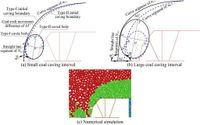The morphology of the coal-rock interface plays a pivotal role in determining the efficiency of coal caving operations, according to new research from the Tang'an Coal Mine in China. This study uncovers that variations in the interface shape can significantly impact the recovery of top coal, addressing a critical issue in the mining industry where maximizing yield while minimizing waste is paramount.
Published on March 19, 2025, this research utilized particle flow code simulations (PFC2D) to analyze different caving intervals of 0.8, 1.6, and 2.4 meters at a mining face characterized by a height of 3 meters and a meticulously monitored mining-to-caving ratio of 1:1. The study highlights how these parameters interconnect to affect the overall mining effectiveness.
As fully mechanized caving has become a standard method for extracting thick coal seams, especially within key regions such as Henan, Shanxi, and Shaanxi, challenges like low top coal recovery have persisted. The findings of this study provide much-needed insights into these operational challenges. By forming a quantitative relationship between the morphology of the coal-rock interface and the recovery rate, researchers aim to optimize extraction processes and enhance economic returns.
“The changing trend of coal-caving initial boundary θ1 determined coal-caving final boundary θ2 and corresponding coal-rock interface morphology,” wrote the authors of the article, emphasizing the importance of understanding these dynamic characteristics. Initial boundary θ1 varies in both time and space, revealing that depending on the angles and conditions of the interface, different types of coal-rock interfaces emerge. These include classifications identified through simulations, such as types AI, AII, BI, BII, and CI, which help in predicting mining behaviors.
The study showed that for initial boundary angles over 90 degrees, the final caving boundary angle closely matched the initial one (θ1 ≈ θ2). Conversely, when θ1 fell below 90 degrees, the final boundary angle was consistently smaller than the initial. These insights are crucial for establishing optimal mining strategies that can minimize residual coal left in the goaf and improve overall productivity.
The research further quantified the immediate roof thickness required for efficient coal extraction, determining that a thickness of 6.9 meters is necessary based on coal properties and local geological conditions. This finding has broad implications for operational protocols in the Tang'an Coal Mine and similar mining contexts.
The coal caving ratios identified during the study revealed significant variations: 86.7% at a caving interval of 0.8 meters, 79.4% at 1.6 meters, and 75.6% at 2.4 meters. These statistics underline the effectiveness of tighter caving intervals in maximizing coal recovery, a vital takeaway for miners looking to enhance operational efficiency.
Ultimately, this study points toward more intelligent coal caving control methods reliant upon understanding the coal-rock interface's spatiotemporal characteristics, paving the way for improved mining practices in the future. As the need for efficient resource extraction grows amidst rising demand, such research is invaluable for maintaining sustainable mining operations while ensuring economic viability.
In conclusion, understanding the relationship between coal-rock interface morphology and top coal recovery rates offers critical insights that could spur advancements in mining technologies. This level of depth in investigation not only enhances the operational efficacy of current methods but also sets the foundation for future innovations in coal mining.

